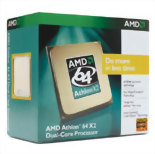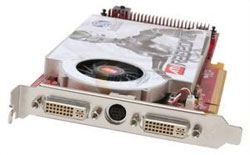Upgraded AMD Midrange Platform
Moving on to the upgraded recommendations for our midrange platforms, the AMD vs. Intel story doesn't change much. Motherboard options on the AMD platform are better if you're looking for multiple GPU support, while overall performance is going to be lower. We have upgraded almost every component in order to provide a better overall system. Base performance will be higher, overclocking capability will generally be better, and the expansion options are also improved. Here is the upgraded AMD platform recommendation.
 |
If you're willing to choose an AMD platform right now, processor performance shouldn't be your primary concern. As we have stated, Intel's Core 2 Duo is going to be faster at virtually every price point. Nevertheless, we have upgraded the CPU slightly from the 3800+ to the 4200+. That adds 10% more CPU clock speed for a 22% increase in CPU cost. Other than the discontinued 1 MB cache 4000+, which will be slower than the 4200+ in nearly every instance, the next possible CPU upgrade for socket AM2 is the 4600+. That adds another 200 MHz but it costs $110 more, so we really wouldn't go beyond the 4200+ if you're trying to build a midrange computer.
 |
We have a few options on the motherboard as an "upgrade". We typically feel nForce 590 SLI boards are a bit too expensive to fit into a midrange budget, and they really don't offer a lot more performance than nForce 570 SLI anyway. Instead of making a minor upgrade to the chipset performance, we have swapped NVIDIA chipsets for an ATI chipset, thus gaining CrossFire support and losing SLI support (official support at least). Unfortunately, while our initial look at the ATI Xpress 3200 showed that it was a capable overclocker, few manufactures seem to have fully tapped the potential. If you're looking for maximum overclocking capability, you may need to stick with an nForce 570/590 chipset, but the MSI K9A Platinum still performs well and offers a moderate amount of overclocking support.
 |
We upgraded the memory selection for both platforms, although Core 2 Duo is more likely to make use of the extended bandwidth. Memory prices are extremely volatile right now, with both AMD and Intel moving to DDR2 and the impending holiday season. The Crucial 2x1024MB PC2-6400 Ballistix uses high quality Micron memory and is rated for 4-4-4-12 and 2.2V operation. It should reach as high as DDR2-1000 and 5-5-5-15 timings with 2.3V, and possibly a bit more if you go beyond 2.3V. That is certainly enough bandwidth for socket AM2, and all but the most extreme overclocks with Core 2 Duo shouldn't present a problem. As before, many other manufacturers offer competing RAM: Corsair, G.Skill, OCZ, PDP, and others manufacture memory rated at DDR2-800 or higher, although prices can quickly reach extreme levels for the highest performance memory. We have already changed the memory recommendation once, due to rapidly fluctuating prices. Hopefully the RAM prices will return to normal soon, although it may take until the New Year for that to happen.
 |
With the change to an ATI chipset, it shouldn't come as a surprise that we also changed to an ATI graphics card, the Sapphire X1900 GT. The X1900 GT offers competitive performance to its NVIDIA counterpart (the 7900 GS), and prices are similar. Depending on your game of choice, the X1900 GT may be slower or faster than a 7900 GS, and overclocked 7900 GS cards are also available. With the ATI Xpress 3200 chipset, however, you will probably prefer an ATI graphics card. If you should instead decide to stick with an nForce 570 SLI motherboard, 7900 GS cards are readily available. The EVGA GeForce 7900GS KO 256MB HDCP offers some interesting features that the Sapphire X1900 GT lacks, for example HDCP support. For gamers on a budget, either card should suffice, and either card can be upgraded to a dual-GPU solution in the future should you so desire.














49 Comments
View All Comments
JarredWalton - Tuesday, September 26, 2006 - link
Caps are often one of the most critical factors in overclocking. Obviously, the difference isn't huge, and neither is the difference in price (about $20 more for the DS3). "A bit better" means that you will really have to be pushing hard to reach that point; RAM is likely to give out before either motherboard.RamarC - Tuesday, September 26, 2006 - link
IMHO, the upgraded Intel config can be improved quite a bit for $82 more ($37 more w/available rebates). I'd move up to an E6600, select ASUS P5B-E mobo, and use dual hard drives in matrixRAID. An Antec Sonata II w/450W PS would be subbed in for the case. This config will be plenty fast in 'stock' form and still has some OC headroom.Core2Duo E6600 . . . . . 319
ASUS P5B-E . . . . . . . 164
OCZ 2GB Gold Gamer DDR2-800 . 260
GeForce 7900GS
or Radeon x1900gt . . .. 206
2 WD 1600JS 160GB . . . . 124
LiteOn 165H6S retail . . . 42
Acer AL2216WBD 22" WS . . . 337
Antec Sonata II w/450W PS . 110
Logitech Premium . . . . 30
Windows XP MCE . . . . . 120
Total . . . . . . . . .. . $1,712
rjm55 - Tuesday, September 26, 2006 - link
I'm in total ageement with your idea. I was more than a little surprised to see the lowest 2MB cache Core 2 Duo as the choice in the first Intel, but I figured it would be fixed in the the upgrade choice with a 4MB cache model. It wasn't. The 4MB cache does make a performance diffence and is always faster at the same speed. I would pick a E6600 for my own midrange system.I would also choose a lowend 975 for the true dual x8 Crossfire. Abit has a decent 975 board for $159. This would actually be $5 less than your setup with a 965 board.
JarredWalton - Wednesday, September 27, 2006 - link
I added some clarification on the "upgraded" Core 2 page for you guys. :)Basically, your selections are perfectly acceptable alternatives, but if I were to put up my upgraded build with overclocking agains your upgraded builds, I would wager I can get better overall performance. Not everyone wants to overclock, and that's fine, but my picks were made with a bit more of an overclocking bias.
The $260 OCZ DDR2-800 doesn't OC very well at all, while the $280 RAM does much better. In fact, the $260 RAM you link has had some compatibility issues with some motherboards (it wants to POST with higher voltages for the listed timings, IIRC), so you would be better off getting the $220 OCZ DDR2-667 in my book.
The bottom line is that you have to determine what you want to do with the PC. For gaming (you mention CrossFire), spend a lot of money on the GPUs before you even worry about upgrading the CPU (unless you run games at 1024x768). If you plan on running X1900 CrossFire, though, you really better think about upgrading to a nice PSU like the Fotron Source listed. For X1900 XT CrossFire (or X1950 CF), you should probably go with a Fotron Source 700W (or OCZ GameXStream, Thermaltake 700W, or several others which are just rebranded FSP units).
JarredWalton - Tuesday, September 26, 2006 - link
I unfortunately have to say that Antec PSUs have gone way downhill in the past year. Ask Gary how many dead Antec units he has sitting around. Other than that, though, you demonstrate exactly what I tried to point out: there are a ton of different ways to attack a midrange build, especially at the $1500-$1700 price point. We went with better RAM and a much better PSU with a lower end CPU. RAID won't really help performance much IMO (unless you want RAID 1 for redundancy), and I would rather have a single drive instead of two drives for the same amount of storage (cheaper too).As for the CPU, the E6600 is definitely faster. With overclocking, it's lot closer, as the 2MB cache Core 2 Duos will generally overclock further than the 4MB cache CPUs. At that point, you have to decide whether you really need faster CPU performance or if you should improve something else. If you play games as your primary focus, even the X2 3800+ will be essentially tied with the E6600 until you start to get into much faster GPUs.
RamarC - Tuesday, September 26, 2006 - link
I'm a big fan of MatrixRaid. Dual 160s can be config'd as a 40gb mirror (boot, OS, important docs, etc.), and a 220gb strips set (game files, mp3s, dvd rips, page file, temp folder, etc.). A bit more expensive than a single drive, but a more performance and much safer.You guys obviously go through PSs more than me. Still, I'd rather spend about the same cash and get a faster stock system than one that I have to OC to reach the same level of performance.
Araemo - Tuesday, September 26, 2006 - link
I didn't see any discussion of it in the article, but which of those monitors are 24 bit(8 bit panels)?I'm rather picky about colors, and I wouldn't consider any 6 bit panels. I've seen 8 bit panels with good enough refresh times(Using overdrive) from some companies, but it can be such a PITA to find out for sure if a given monitor uses a panel that is 8 bit or 6 bit, that I would like to see that kind of information noted when a recommendation is being made...
Super Nade - Tuesday, September 26, 2006 - link
Hi,I have serious issues regarding the PSU's being recommended. Why are you guys skimping on a no-name, possibly dodgy PSU? To keep things in budget, I'd suggest cutting back on the case and the DRAM, possibly substituting a 17 inch display for the 19 inch. There are several good reasonably priced PSU's (say $80 range)available.
I like the article and agree with most of the recommendations, but for the PSU :)
Regards,
S-N
Revolutionary - Wednesday, September 27, 2006 - link
Everybody questioning the choice of a Fortron-Source PSU because they "have not heard of them" needs to get a clue.They MAKE power-supplies as an ODM. Often the Antec, Enermax, whatever-pricey-name-brand-you-want-to-insert PSU is just a re-badged FS model.
And if you check out the "cool-n-quiet" community, you will find that FSP actually has quite a following. I've personally used 3 of their PSUs (I'm still using one, actually: a 300W 120mm fan model that I bought about 3 years ago...).
Mass marketing brand awareness does not a good component make.
Gary Key - Tuesday, September 26, 2006 - link
While I am one to usually advocate buying a 700W or above power supply for any system ;-> , we looked at the baseline system requirements and determined the included power supply from Gigabyte was adequate to meet the systems needs. There are numerous case/power supply choices in this range and most of the tier one case suppliers provide decent power supplies. I for one like the Cooler Master Centurion 5 combo with their 380w power supply for a base system. Obviously, if you designed a system around the base configuration and wanted to overclock your system (in the case of the AMD unit, also run SLI) then a better power supply is certainly warranted.In the upgraded configuration I think our power supply choice reflected one of the best price/performance choices in the 500W~600W range. There was another FPS 550W power supply that was actually at the top of our list for a couple of more dollars but it was sold out at the majority of on-line stores.
:)